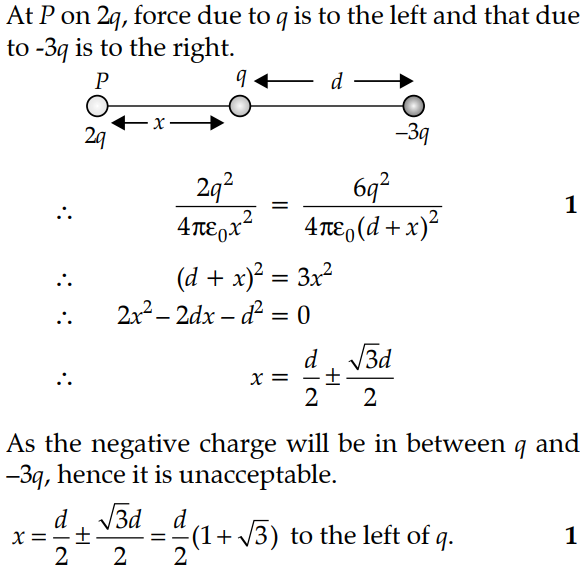Two charges q and –3q are placed on x-axis separated by distance d. Where a third charge 2q should be placed such that it will not experience any force ?

Two charges of 2uC and 5uC are placed 2.5 cm apart. The ratio of Coulomb's force experienced by them is
A charge q is placed at one corner of the cube. The electric flux passing through any one of its face is
Two-point charges 2μC and 4μC are placed 2 cm apart. The ratio of the Coulomb’s force experienced by them is
(A) 1: 2
(B) 2: 1
(C) 1: 1
(D) 4: 1
Two point charges q1 and q2 are located at points (a, 0, 0) and (0, b, 0) respectively. Find the electric field due to both these charges at the point (0, 0, c).
A point charge +Q is placed in the vicinity of a conducting surface. Draw the electric field lines between the surface and the charge.
Derive an expression for electric field of a dipole at a point on the equatorial plane of the dipole. How does the field vary at large distances?
Three charges each equal to 2 μC are placed at the corners of an equilateral triangle. If force between any two charges is 2F, then the net force on either will be:
The figure shows a plot of terminal voltage ‘V’ versus the current ‘i’ of a given cell. Calculate from the graph
(i) emf of the cell and (ii) internal resistance of the cell.
An electric dipole of length 4 cm, when placed with its axis making an angle of 60° with a uniform electric field, experiences a torque of Nm. Calculate the potential energy of the dipole, if it has charge ± 8 nC.
Find the expression for electric field intensity in an axial position due to electric dipole.
Draw a graph showing variation of resistivity with temperature for nichrome. Which property of nichrome is used to make standard resistance coils ?
A battery of emf E and internal resistance, r, when connected with an external resistance of 12Ω produces a current of 0.5 A. When connected across a resistance of 25Ω, it produces a current of 0.25 A. Determine
(i) the emf and (ii) the internal resistance of the cell.
A lamp is connected in series with a capacitor. Predict your observation for dc and ac connections. What happens in each if the capacitance of the capacitor is reduced ?
A battery of emf 12 V and internal resistance 2 Ω is connected to a 4 Ω resistor as shown in the figure.
